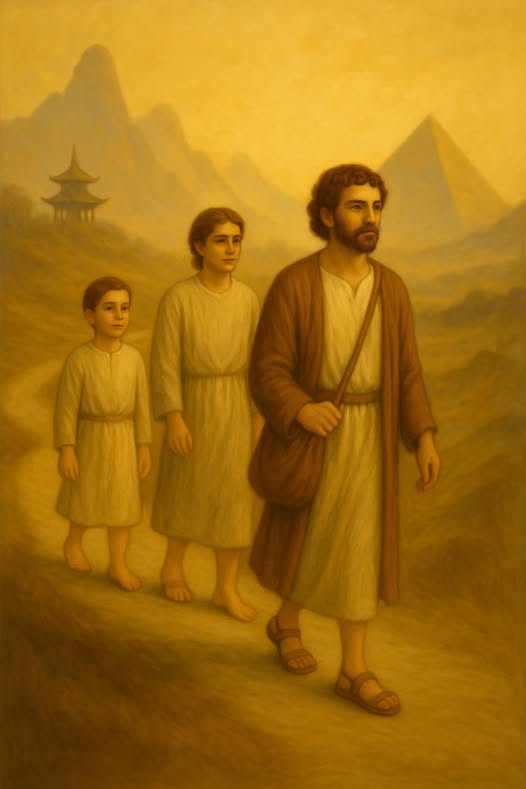The Lost Years of Jesus – A Spiritual Quest Beyond Dogma

Exploring the forgotten journey of a young master in the making – through the lens of A Course in Miracles
Introduction: Where was Jesus from age 12 to 30?
In the canonical Bible, a curious silence surrounds Jesus between the age of twelve (the temple scene) and his public appearance at thirty.
These 18 years of biography are missing, as if someone simply said: “he was born, became a smart kit ….and suddenly was baptized by John.” But if we dare to look beyond the veil of religious control and historical selectivity, we find an intriguing image of a searching young man on the path to spiritual mastery. Not as a god on Earth, but as a student – just like you and me.
⸻
1. A Student Among Teachers: The Inward Journey Through the East
According to many alternative sources, Jesus spent his so-called “lost years” traveling through India, Tibet, and Egypt. He is referred to as “Issa” in ancient texts from the Hemis monastery in Ladakh, and in oral traditions passed down by Tibetan monks. This Jesus is described as a peaceful master who spoke of universal love, compassion, and inner awakening.
Why is this important?
Because the image that emerges is not that of a “naturally divine Jesus,” but of a young man who, just like us, was taught, doubted, searched, and eventually found. His becoming a teacher came from first being a student. And that makes him a true brother in Spirit – not an idol on a pedestal.
⸻
2. The Path of Initiation: Mystery Schools and Inner Transformation
In Egypt, Jesus is said to have been initiated into the mystery schools of Isis, Osiris, and Thoth – institutions that had, for centuries, provided spiritual training in inner alchemy: releasing the ego, disidentifying with the body, and awakening to Christ consciousness. (Thoth referred to this world as an illusion – a dream from which we can awaken, an idea that perfectly aligns with the Course.)
Edgar Cayce’s readings support this narrative and also speak of Jesus’ experiences in India, where he studied with yogis and Vedic teachers.
This resonates beautifully with the message of A Course in Miracles:
“You believe you are a body, and therefore believe in what the body tells you. But you are not a body. You are free.”
(Lesson 199)
Jesus as a student of that truth? It makes his later words all the more powerful.
⸻
3. Why These Years Were Omitted: The Fear of a Free Spirit
According to Paul Wallis and many other spiritual researchers, the early Church deliberately chose not to include these years in the canon. Why? Because the image of a searching, traveling, human Jesus did not align with the Roman-inspired system that needed a God on a throne – not a teacher who says:
“What I do, you will do also… and even greater things.”
(John 14:12)
That is a dangerous idea to any system of control.
But it is exactly that which the Course teaches us:
“Jesus is a teacher who remembered HimSelf, and who reminds you that you can do the same.”
⸻
4. The Forgotten Key: Christ Consciousness in You
This alternative view of Jesus does not present a new dogma – it offers an invitation. A remembrance.
If Jesus, in his youth and early adulthood, searched, traveled, struggled, and learned, then we need not feel shame for our own path of falling and rising. In fact, the path itself is the miracle.
He did not become the Christ by birth – he recognized Christ consciousness as his true nature.
And that is exactly what A Course in Miracles invites you and me to remember:
“The Son of God is not lost in dreams, but awakens in the Light of his true Being.”
⸻
Perhaps Jesus really did walk along dusty paths in Ladakh, wrapped in a linen robe, smiling gently as he listened to a Buddhist teacher say:
“There is no ‘I’ that becomes enlightened. Only the Light is and remains.”
Or maybe he sat in a temple in Egypt, staring at a golden Ankh, and realized:
“Eternal life is not a future state, but a remembrance.”
Maybe, just maybe, his journey reminds us that we are all walking toward the same remembrance.
And the real lack ?
That’s the ego saying: “Yeah yeah, nice story… but I’m not there yet.”
We smile, kindly thank the ego… and continue walking.
Together. Just as it was always meant to be.
With love and light,
G.